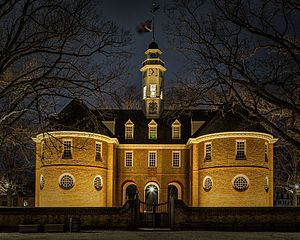Williamsburg Historic District/Williamsburg Historical Triangle | |
From top to bottom (left to right): View of the reconstructed Raleigh Tavern on Duke of Gloucester Street; Gardens at the Governor's Palace; Carriage; Capitol Building at night | |
 Interactive map showing the location of Williamsburg Historical District | |
| Location | Bounded by Francis, Waller, Nicholson, N. England, Lafayette, and Nassau Sts., Williamsburg, Virginia |
|---|---|
| Coordinates | 37°16′17″N 76°42′00″W / 37.27139°N 76.70000°W |
| Area | 173 acres (70 ha) |
| Built | 1699 |
| Architectural style | Georgian |
| Website | www |
| NRHP reference No. | 66000925[1][2] |
| VLR No. | 137-0050 |
| Significant dates | |
| Added to NRHP | October 15, 1966 |
| Designated NHLD | October 9, 1960 |
| Designated VLR | September 9, 1969[3] |
Colonial Williamsburg is a living-history museum and private foundation presenting a part of the historic district in the city of Williamsburg, Virginia. Its 301-acre (122 ha) historic area includes several hundred restored or recreated buildings from the 18th century, when the city was the capital of the Colony of Virginia; 17th-century, 19th-century, and Colonial Revival structures; and more recent reconstructions. The historic area includes three main thoroughfares and their connecting side streets that attempt to suggest the atmosphere and the circumstances of 18th-century Americans. Costumed employees work and dress as people did in the era, sometimes using colonial grammar and diction.[4]
In the late 1920s, the restoration of colonial Williamsburg was championed as a way to celebrate patriots and the early history of the United States. Proponents included the Reverend Dr. W. A. R. Goodwin and other community leaders; the Association for the Preservation of Virginia Antiquities (now called Preservation Virginia), the Colonial Dames of America, the Daughters of the Confederacy, the Chamber of Commerce, and other organizations; and John D. Rockefeller Jr. and his wife Abby Aldrich Rockefeller.
Along with Jamestown and Yorktown, and the Colonial Parkway, Colonial Williamsburg is part of the Historic Triangle in Virginia, The site was once used for conferences by world leaders and heads of state. In 1960, it was designated a National Historic Landmark District.[2]
- ^ "National Register Information System". National Register of Historic Places. National Park Service. March 13, 2009.
- ^ a b "Colonial Williamsburg". National Historic Landmark summary listing. National Park Service. Archived from the original on October 6, 2012. Retrieved June 27, 2008.
- ^ "Virginia Landmarks Register". Virginia Department of Historic Resources. Archived from the original on 21 September 2013. Retrieved 19 March 2013.
- ^ "Next Williamsburg visit could include an 18th-century coffeehouse experience | Richmond Times-Dispatch". October 6, 2012. Archived from the original on October 6, 2012. Retrieved August 10, 2023.





